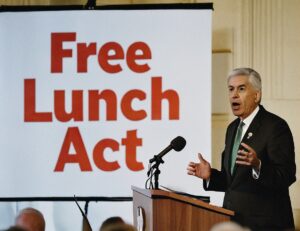Showing archive for: “Health Care”
The year ahead in drug pricing.
Last week, several major drug makers marked the new year by announcing annual increases on list prices. In addition to drug maker Allergan—which pledged last year to confine price increases below 10 percent and, true to its word, reported 2018 price increases of 9.5 percent—several other companies also stuck to single-digit increases. Although list or “sticker” ... The year ahead in drug pricing.
Just in Time for Christmas: How to Regulate
My new book, How to Regulate: A Guide for Policymakers, is now available on Amazon. Inform Santa! The book, published by Cambridge University Press, attempts to fill what I think is a huge hole in legal education: It focuses on the substance of regulation and sets forth principles for designing regulatory approaches that will maximize social ... Just in Time for Christmas: How to Regulate
Inter Partes Review Jeopardizes the Social Contract between Drug Makers and Patients
It’s been six weeks since drug maker Allergan announced that it had assigned to the Saint Regis Mohawk Tribe the patents on Restasis, an Allergan drug challenged both in IPR proceedings and in Hatch-Waxman proceedings in federal district court. The unorthodox agreement was intended to shield the patents from IPR proceedings (and thus restrict the ... Inter Partes Review Jeopardizes the Social Contract between Drug Makers and Patients
The Allergan-Mohawk deal: An ingenious strategy to avoid an unbalanced IPR process
Last Friday, drug maker Allergan and the Saint Regis Mohawk Tribe announced that they had reached an agreement under which Allergan assigned the patents on its top-selling drug Restasis to the tribe and, in return, Allergan was given the exclusive license on the Restasis patents so that it can continue producing and distributing the drug. ... The Allergan-Mohawk deal: An ingenious strategy to avoid an unbalanced IPR process
How a Patent Office Agency Undermines Patent Rights and Cripples Innovation – and What Can Be Done About It
On August 14, the Federalist Society’s Regulatory Transparency Project released a report detailing the harm imposed on innovation and property rights by the Patent Trial and Appeals Board, a Patent and Trademark Office patent review agency created by the infelicitously-named “America Invents Act” of 2011. As the report’s abstract explains: Patents are property rights secured ... How a Patent Office Agency Undermines Patent Rights and Cripples Innovation – and What Can Be Done About It
An Apollo 13 approach to Obamacare
“Houston, we have a problem.” It’s the most famous line from Apollo 13 and perhaps how most Republicans are feeling about their plans to repeal and replace Obamacare. As repeal and replace has given way to tinker and punt, Congress should take a lesson from one of my favorite scenes from Apollo 13. “We gotta ... An Apollo 13 approach to Obamacare
Voluntary pricing restraints in the drug industry
Today, the Senate Committee on Health, Education, Labor, and Pensions (HELP) enters the drug pricing debate with a hearing on “The Cost of Prescription Drugs: How the Drug Delivery System Affects What Patients Pay.” By questioning the role of the drug delivery system in pricing, the hearing goes beyond the more narrow focus of recent hearings that ... Voluntary pricing restraints in the drug industry
Innovation trends in agriculture and their implications for M&A analysis
The US agriculture sector has been experiencing consolidation at all levels for decades, even as the global ag economy has been growing and becoming more diverse. Much of this consolidation has been driven by technological changes that created economies of scale, both at the farm level and beyond. Likewise, the role of technology has changed ... Innovation trends in agriculture and their implications for M&A analysis
Understanding innovation markets in antitrust analysis
Today, three of the largest proposed mergers — Bayer/Monsanto, Dow/Dupont, and ChemChina/Syngenta — face scrutiny in both the U.S. and Europe over concerns that the mergers will slow innovation in crop biotechnology and crop protection. The incorporation of innovation effects in the antitrust analysis of these agricultural/biotech mergers is quickly becoming more mainstream in both the U.S. ... Understanding innovation markets in antitrust analysis
Significant Impediment To Industry Innovation: A novel theory of harm in EU merger policy?
In Brussels, the talk of the town is that the European Commission (“Commission”) is casting a new eye on the old antitrust conjecture that prophesizes a negative relationship between industry concentration and innovation. This issue arises in the context of the review of several mega-mergers in the pharmaceutical and AgTech (i.e., seed genomics, biochemicals, “precision ... Significant Impediment To Industry Innovation: A novel theory of harm in EU merger policy?
ABA Antitrust Section Transition Report: A Respectful Critique
The American Bar Association Antitrust Section’s Presidential Transition Report (“Report”), released on January 24, provides a helpful practitioners’ perspective on the state of federal antitrust and consumer protection enforcement, and propounds a variety of useful recommendations for marginal improvements in agency practices, particularly with respect to improving enforcement transparency and reducing enforcement-related costs. It also ... ABA Antitrust Section Transition Report: A Respectful Critique
Understanding government negotiation of Medicare drug prices
In a weekend interview with the Washington Post, Donald Trump vowed to force drug companies to negotiate directly with the government on prices in Medicare and Medicaid. It’s unclear what, if anything, Trump intends for Medicaid; drug makers are already required to sell drugs to Medicaid at the lowest price they negotiate with any other buyer. ... Understanding government negotiation of Medicare drug prices





